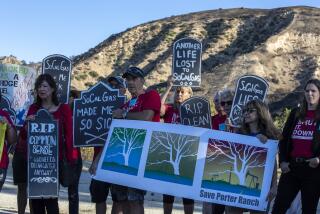Mayor Seeks Delay in Gas Cutbacks to Power Firms
- Share via
Calling it the “worst time of the year” to burn oil in the smog-plagued Los Angeles area, Mayor Tom Bradley on Thursday proposed that Southern California Gas Co. wait until winter to cut supplies of cleaner-burning natural gas to local power utilities.
If the gas company delays its cutback until the peak smog season is past, Bradley said, the harmful effect of burning of oil as a substitute for gas will be reduced. Southern California Gas began on Tuesday cutting back supplies of natural gas to its utility customers, forcing the power companies to turn to oil to make up the difference. The fuels are used to fire power-producing generators.
Southern California Gas said that because of an unusually high drain on its natural gas reserves over the last two years from such factors as the drought, the utility will curb its supplies to local power companies at least until Nov. 1.
No Guarantees
The gas company said it will try to continue to provide full supplies to utilities in the event of a smog episode, such as occurred Wednesday, but no guarantees were made.
Bradley said the gas company’s move to curtail sales to the Department of Water and Power, Southern California Edison Co. and several other utilities could jeopardize efforts to curb smog.
“We’re fighting now to reduce the air pollution in this region,” Bradley said. “This seems to be the worst time in the year to curtail the delivery of natural gas, forcing these utilities to burn heating oil that produces a great deal more pollution.”
The mayor said that to help reduce the demand for natural gas, he will promote immediate energy conservation efforts throughout the city, including government buildings. Among suggestions he backed were the turning up of air-conditioning thermostats by 2 degrees and the curtailing of electricity use during afternoon peak periods.
In response to Bradley’s proposals, gas company officials voiced cautious optimism that an agreement may be worked out to modify the curtailment, but they warned that the electric utilities may be forced to pay a price.
“Obviously we’re interested in mitigating air quality problems as much as anybody,” said Rich Nemec, a Southern California Gas spokesman. “But the utilities must be willing to pay the extra cost.”
Nemec explained that supplying additional gas to the power utilities as well as residential and commercial customers would require Southern California Gas to pay a higher price for new sources of gas. That additional cost would in turn be passed on to the ratepayer, Nemec said.
Stanley Hullett, president of the state Public Utilities Commission (PUC), said that Bradley “has the right concept in mind,” but added that the mayor’s seasonal trade-off plan could actually lead to higher prices.
Hullett explained that if Southern California Gas continued to supply the power utilities at previous levels, it would not meet its “storage targets” of 68 billion cubic feet of gas by Nov. 1. To make up the shortfall, Hullett added, the gas company would be forced to buy new supplies that by winter could cost nearly twice the current price.
Hullett said that he and Bradley will meet next week to discuss a new strategy that could lead to additional gas supplies for the area without hurting the average residential customer.
The burning of natural gas generates about one-half of the nitrogen oxide that is emitted when low-sulfur oil is burned. Nitrogen oxide is a key component of ozone that leads to photochemical smog in the presence of sunlight. Another advantage that burning of natural gas has over oil is that none of the sulfur dioxides produced from oil are generated, officials said.
A gas company spokesman said the various power-generating utilities normally use about 1 billion cubic feet of gas a day, but in recent weeks that had climbed to about 1.3 billion cubic feet a day. Under the curtailment plan, Southern California Gas is expected to cut supplies to the various utilities it serves by about 200 million cubic feet per day, the spokesman said.
Gas company officials said that it takes roughly the equivalent of 33,000 barrels of oil a day to make up for the 200 million cubic feet of natural gas that will not be available to the utilities through Oct. 31. Southern California Edison officials estimated even higher, saying earlier this week that up to 55,000 barrels of oil would be needed to meet normal needs if the gas curbs are not lifted.
One of the key reasons for the higher demand for gas is the reduction in hydroelectric generation caused by the drought that has plagued much of the nation over the last two years. In normal usage, most of the DWP’s power is generated from hydroelectric sources.
As a direct result of the drought, Southern California Edison and the DWP had used some of their natural gas to generate power that in turn was sold to Pacific Gas & Electric in Northern California. The two local utilities, which buy about 75% of Southern California Gas Co.’s power-generating gas, were then forced to seek even more gas to make up the difference.
More to Read
Sign up for Essential California
The most important California stories and recommendations in your inbox every morning.
You may occasionally receive promotional content from the Los Angeles Times.













